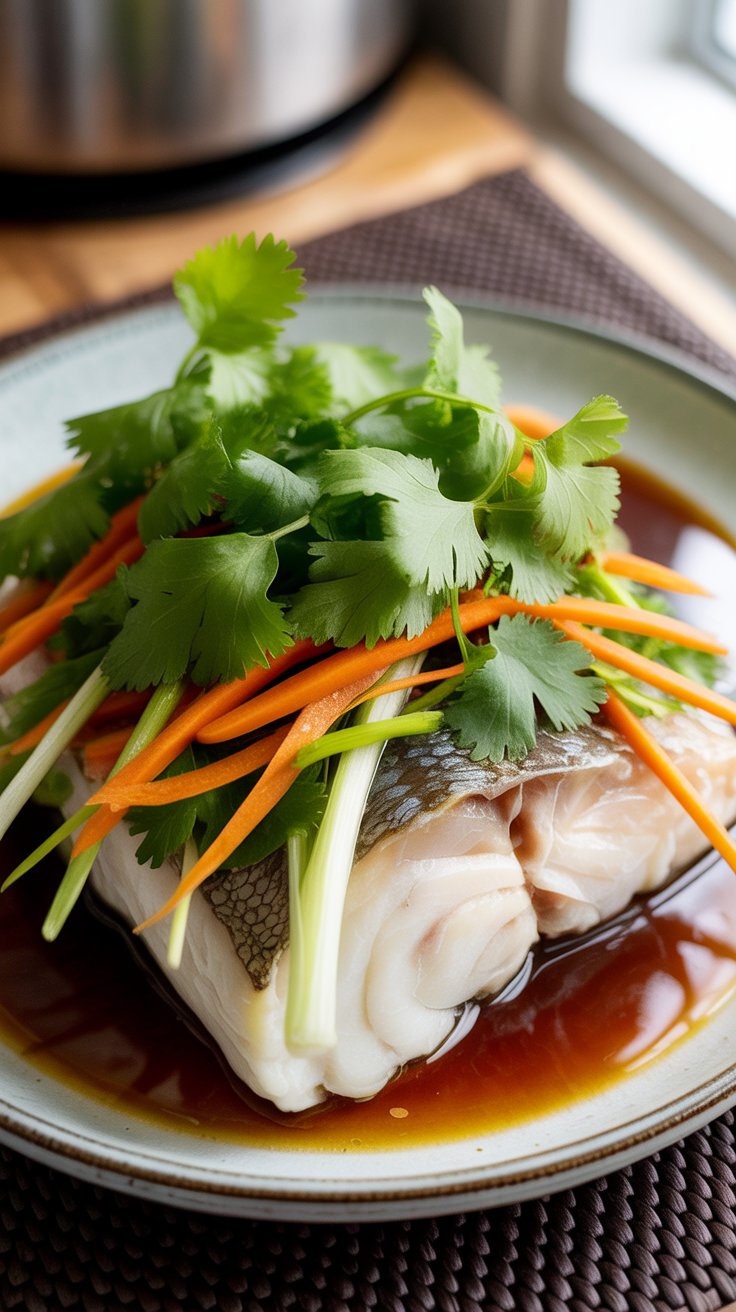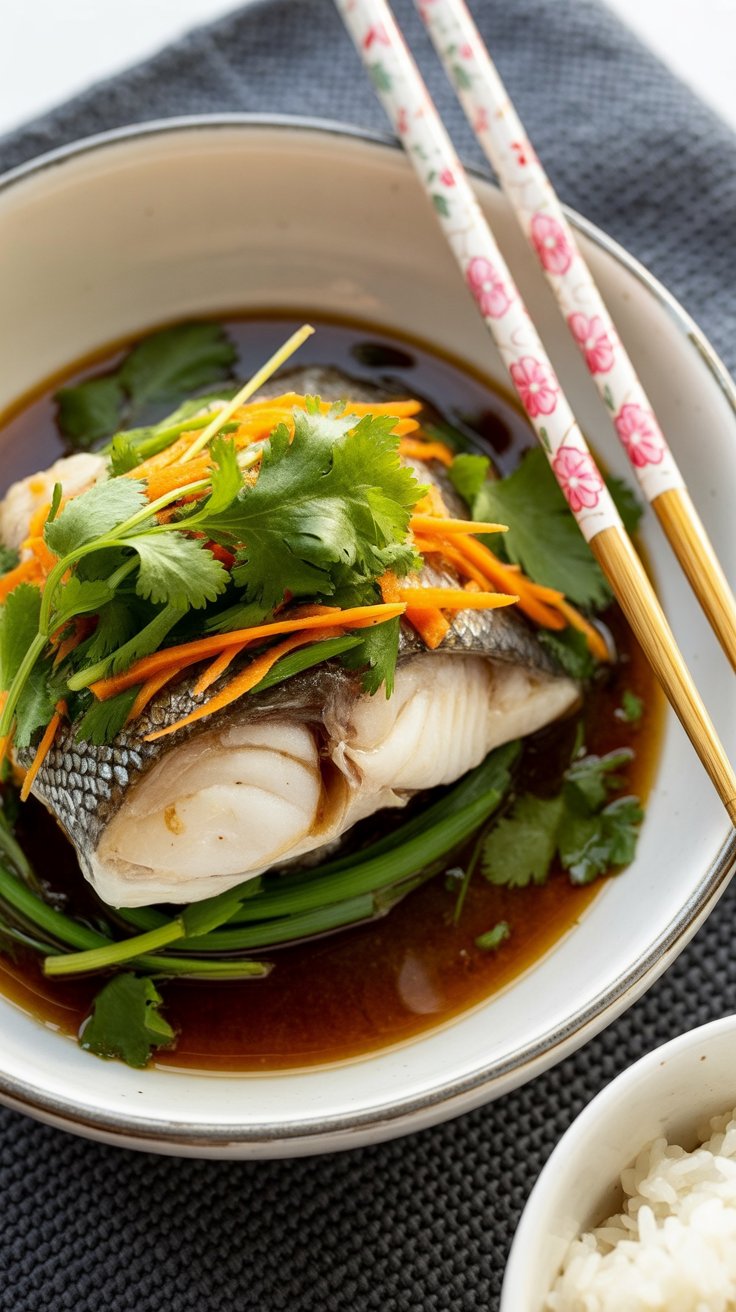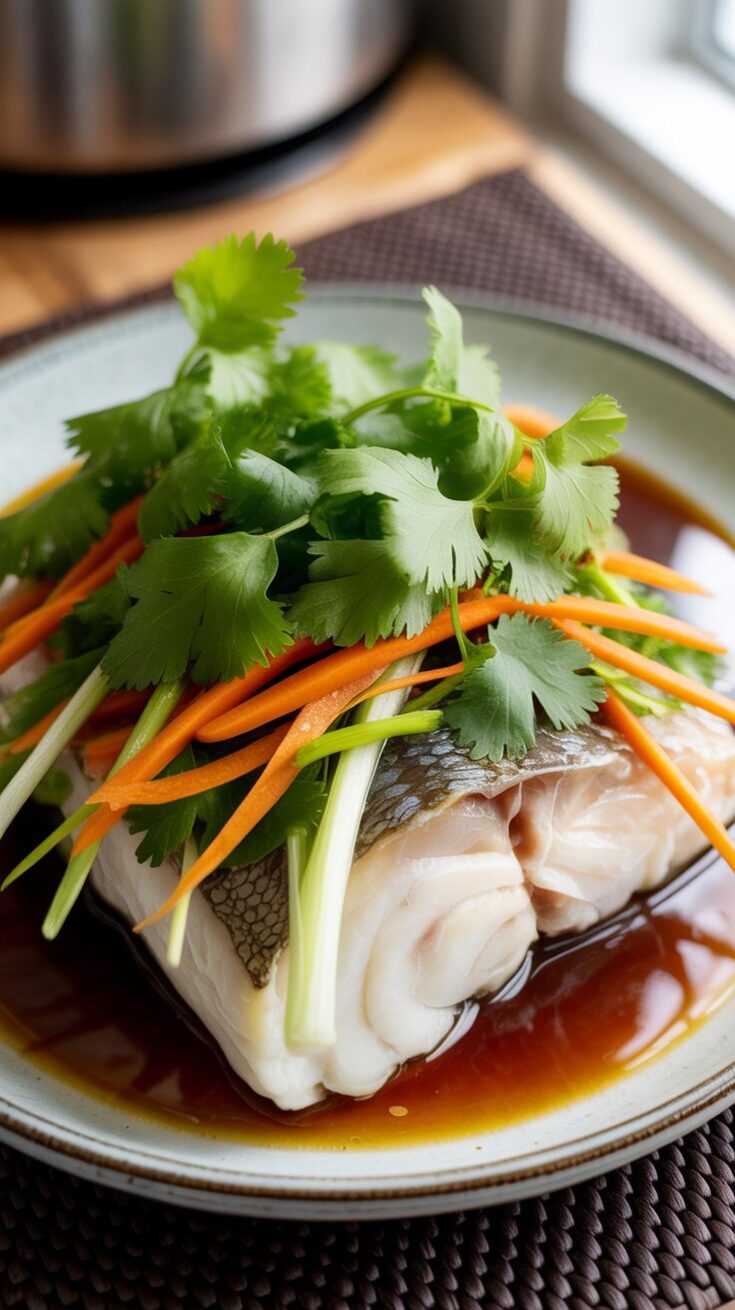Steamed fish has always been one of those dishes that feels both comforting and refreshing. The first time I had this style of fish was at a small family-run restaurant, and I was blown away by how clean yet flavorful it tasted. Years later, I started steaming fish at home, and I realized how approachable it really is—you don’t need fancy equipment or professional chef skills. All you need are fresh ingredients and a steamer basket (or even a pot with a makeshift insert).

This version with ginger, scallion, and soy sauce is one of my favorites. It’s light, nourishing, and comes together in about 30 minutes. Paired with a bowl of hot rice, it always reminds me of the kind of home-cooked meals I crave after a long day.
Why You’ll Want to Cook This
Steamed fish often looks like something you’d only order at a restaurant, but it’s surprisingly easy to make at home. The ginger cuts through any fishiness and adds warmth, while the soy sauce brings depth and savoriness. Scallions and carrots not only brighten the dish visually but also add layers of aroma and freshness.
What I love about this dish is how adaptable it is. I’ve made it for family dinners, where everyone digs in at the table, and I’ve also cooked it just for myself when I wanted something light but satisfying. The flavor feels delicate yet complete—you don’t need heavy sauces or sides.
Best Fish to Use
I usually reach for white fish fillets like grouper, cod, or halibut. Their mild flavor really lets the ginger-soy sauce shine. Red snapper is another great choice if you can find it.
If you’re feeling adventurous, you can even try salmon. It’s not traditional, but as long as you don’t overcook it, it works surprisingly well with the ginger and soy combination.
Whole fish looks impressive (and tastes fantastic), but for weeknight cooking, I prefer fillets. They cook quickly, serve easily, and don’t come with the challenge of bones at the dinner table.
Ingredients You’ll Need
-
White fish fillets with skin (cod, halibut, grouper, or snapper)
-
Fresh ginger (julienned)
-
Garlic cloves
-
Scallions (cut into thin strips)
-
Onion (sliced)
-
Carrots (julienned for color)
-
Soy sauce
-
Sesame oil
-
Optional: rehydrated shiitake mushrooms for a deeper, earthy note
Kitchen note: The mushrooms are a wonderful addition if you have them, but don’t worry if you don’t. Even without them, the dish is fragrant and satisfying.

How to Steam Fish at Home
-
Prep the aromatics. Slice ginger, scallions, onions, and carrots into thin strips. The thinner you cut them, the prettier they look on the fish.
-
Make the sauce. In a small saucepan, combine soy sauce, sesame oil, and a bit of water. Let it simmer briefly—this step really wakes up the aromatics.
-
Prepare the fish. Place the fillets on a heatproof plate that fits into your steamer basket or pot insert.
-
Steam the fish. Cover and steam for a few minutes, then add the ginger, scallions, and carrots during the second half of cooking. This keeps them crisp-tender and colorful.
-
Serve immediately. Pour the sauce over the fish right before serving.
Tip from my kitchen: I sometimes cover the fish with foil for the first half of steaming to prevent condensation from dripping down and washing away the flavors.
Tips for Success
-
Don’t over-steam. Fish cooks faster than you think. Depending on thickness, fillets can be ready in as little as 8–10 minutes.
-
Slice everything thin. The thinner the aromatics, the quicker they soften and the prettier they look when served.
-
Freshness matters. Since the dish is so simple, fresh fish makes all the difference.
Make Ahead Ideas
-
You can slice all your aromatics earlier in the day and keep them in the fridge. That way, assembling the dish at dinnertime is effortless.
-
The sauce can be simmered ahead of time, cooled, and kept in a jar. Just reheat gently before using.
Serving Suggestions
Steamed fish is always best served with rice—it soaks up the sauce perfectly. I usually go with plain jasmine rice, but brown rice works if you want something heartier.
If I’m cooking for guests, I’ll add a stir-fried green vegetable like bok choy or Chinese broccoli on the side. It turns the whole meal into something that looks restaurant-worthy, but without much extra work.
Storing and Reheating
This dish really shines when eaten fresh, but if you have leftovers, keep them in the fridge in a sealed container for up to 2 days.
To reheat, steam gently again or warm in the microwave with a splash of extra soy sauce to bring back the flavor. I’ve also flaked leftover fish into congee the next morning—it adds amazing depth.

FAQs
Can I use frozen fish?
Yes, but make sure it’s fully thawed and pat it dry before steaming. Too much water will dilute the sauce.
Do I need a steamer basket?
Not necessarily. You can set a heatproof plate over a rack inside a large pot with a lid. Just make sure the plate isn’t sitting directly in the water.
Can I make it without sesame oil?
You can skip it, but sesame oil adds a nutty aroma that really ties the flavors together. If you don’t have it, a drop of neutral oil will still work.
How do I know when the fish is done?
The flesh should turn opaque and flake easily with a fork. Be careful not to go past that point—it only takes a minute or two for perfectly cooked fish to turn dry.
White Fish Fillets with Ginger and Soy

Steamed fish is one of the simplest yet most elegant ways to enjoy fresh seafood.
Ingredients
For the fish
- 12–14 oz white fish fillet, skin-on (such as grouper, halibut, snapper, or cod)
- 2 teaspoons sesame oil
- 1½-inch piece of ginger, julienned
- ½ medium carrot, julienned
- 1 small onion, thinly sliced (or half a medium onion)
- 4–5 scallion stalks, cut into short sections and shredded
- ⅛ teaspoon salt
- a few pinches of black pepper
For the sauce
- 1 tablespoon olive oil
- 2–3 garlic cloves, minced
- 2 small shallots, minced (optional)
- ½ teaspoon minced ginger
- 1½–2 tablespoons soy sauce
- ⅛ teaspoon black pepper
- ⅛ teaspoon salt, or to taste
Instructions
- Place the fish fillet on a shallow, heatproof plate that fits inside your steamer. Rub with sesame oil, a pinch of salt, and a little black pepper. Set aside while preparing the vegetables and aromatics.
- Heat olive oil in a small pan over medium heat. Add the minced garlic and shallots, stirring until fragrant. Mix in the minced ginger, then pour in soy sauce with a dash of pepper and salt. Let it bubble for a few seconds before transferring the sauce to a small bowl.
- Scatter the julienned ginger, onion, and carrots over the fish. Cover the plate with foil and steam for about 8–9 minutes. Remove the foil, spoon the sauce evenly over the fish, and top with the scallions. Return to the steamer uncovered and cook for another 4–6 minutes, or until the fish flakes easily with a fork.
- Serve hot with rice, and if you like, garnish with fresh cilantro.
Final Thought
White fish fillets with ginger and soy is one of those recipes that proves simple cooking can be extraordinary. With just a few ingredients, you get a dish that feels light, comforting, and elegant at the same time.
It’s the kind of meal I turn to when I want something clean yet satisfying, and it always reminds me of family-style dinners where everyone leans over the table, spooning sauce over their rice. Once you’ve tried it, I think it’ll earn a place in your regular rotation, too.

